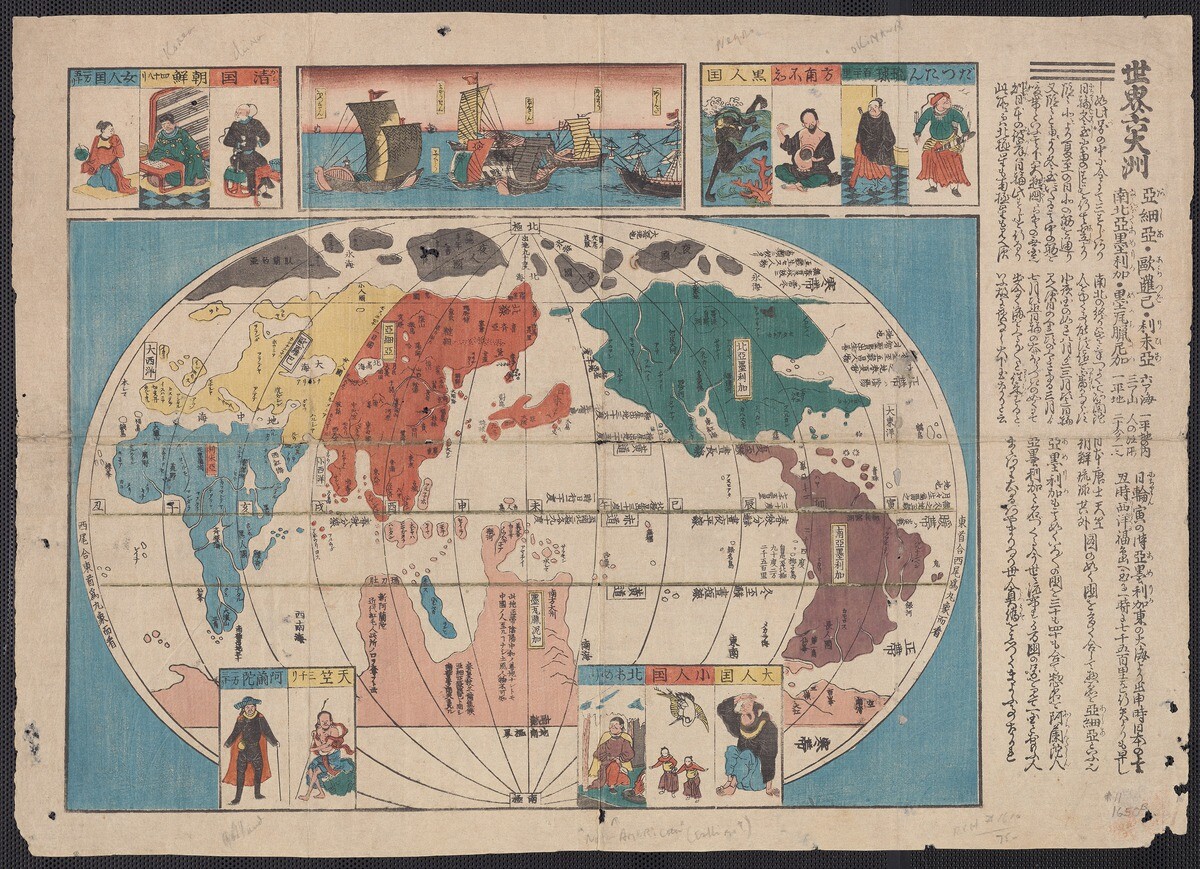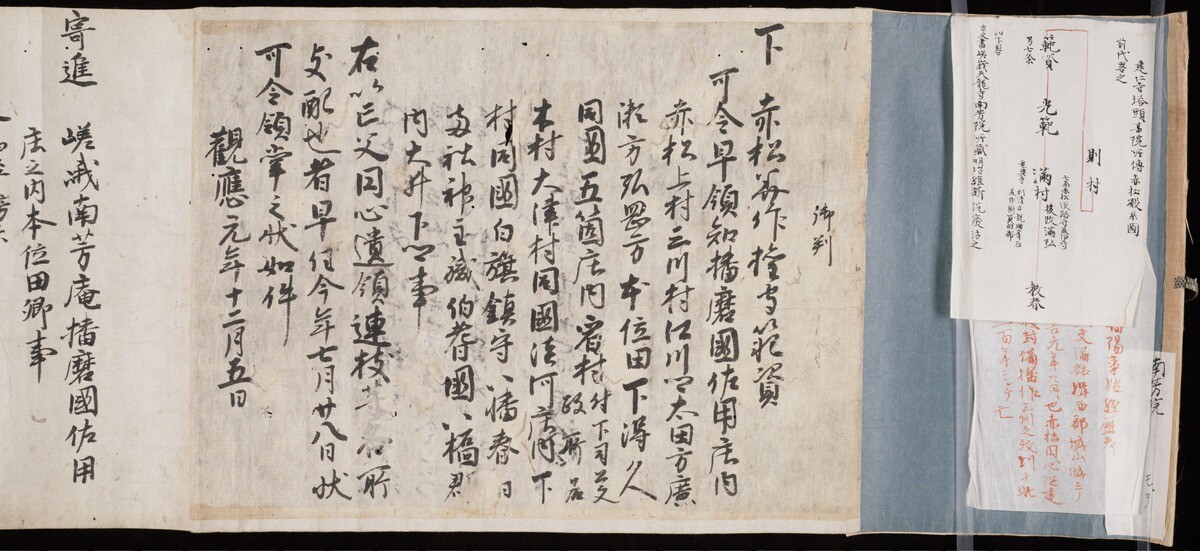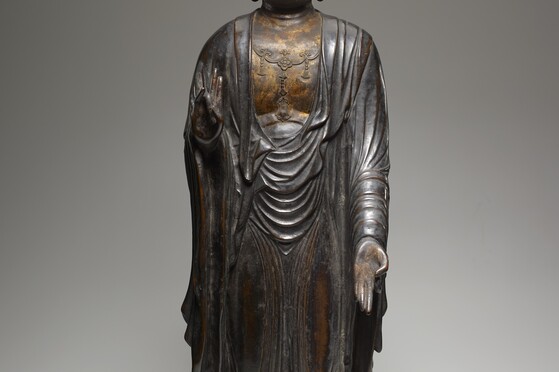The collection of Japanese materials at the Beinecke Rare Book & Manuscript Library includes objects from as early as the eighth century CE and stretches well into the twentieth century. This wide ranging collection encompasses all types of media and document formats. The diversity of these objects provides an opportunity to explore genre, methods of production, manner of dissemination, and displays an impressive mastery of all types of books arts.
From bound printed books to hanging scrolls, the different shapes, styles, and contruction of these objects can tell us much about the various manners and cultures of reading– what is valued about one object or one format may be radically different than another, with features like illustration, block printing, literary texts, and fine calligraphy directing a reader’s or viewer’s attention to varying elements of the object.

Detail, GEN MSS 1479. Hanging Scroll. Sanbō ekotoba fragment. Copied by Toshiyori Minamoto in 1120.
GEN MSS 1479 and GEN MSS 1478 are two fragments of a series that were once united. Copied in a fine caligraphic hand in 1120 CE, these scrolls contain individual sections of a Buddhist text referred to as Sanbō ekotoba or Illustrated Three Jewels. Composed by Tamenori Minamoto (d. 1011). These particular fragments of the three volume work were copied by the poet Toshiyori Minamoto (1055-1120), possibly in the last year of his life. These two sections have been mounted and carefully preserved, prized for their provenance and for their masterful display of calligraphy, as have other remnants of the original whole. Many of these are held in collections around the world, including in museums like the Metropolitan Musem of Art in New York City, which holds three of the existing todaiji-gire.

YAJ 5c0. Taketori monogatari (Nara e-hon). 16th century.
Dated to the sixteenth century, the two volumes of YAJ 5c0 contain the Taketori monogatari or The Tale of the Bamboo Cutter, as well as a series of lively illustrations to accompany the text. The literary folk tale tells the story of Nayotake no Kaguya-hime, a beautiful princess from the Moon. An enduring narrative, the story has received treatment in modern media as recently as 2013 and the Studio Ghibli film The Tale of Princess Kaguya (かぐや姫の物語). As the princess grows, the rumors of her beauty spread and suitors from near and far gather, hoping to catch a glimpse of her radiance or to have the chance to prove their love to her. In the opening above, five such suitors longingly wait for Kaguya-hime just outside the wall of the family home.

11 1650b. Map of the World, circa 1650. Block print.
This impressive block-printed map from 1650 displays pictures the world with the island of Japan at the very center, ringed by other continents. At the top and the bottom of the map, there are small vignettes sent into rectangular frames which depict highly stereotypical (and occasionally fantastical) images of peoples from around the globe. (This device is also found in some early modern European maps— a strange attempt at a kind of visual anthropology!) Also included along the top edge of the map is a maritime scene depicting different types of ships from other global regions, echoing the depictions of national dress that surround it.

Detail, YAJ 10b7. Kingyo sodategusa. After 1748.
Among the many print objects at the Beinecke is this copy of Kingyo sodategusa, an Edo era manual by Yoshiyuki Adachi on caring for and breeding goldfish. In the above opening, a beautifully detailed fish glides across the gutter— almost as if swimming right by the viewer. The block-printed guide provided assistance to those interested in this piscine pet which saw an explosion of popularity during the eighteenth century.
More Information on the Collection at Yale
Yale University Library Guide to Studying Japanese at Yale
On the Yale Association of Japan Collection
More on Japanese Manuscripts at the Beinecke
Select Digitized Highlights of the Collection:
57 1600, Early 17th Century Map of Japan
YAJ 11b8, Annals of the Imperial Court and Nobility, 887-1092
YAJ 2.2, Seven original documents of the monastery Tenryūji, between 1350 and the early 15th century
YAJ 5b0, Tekagamijō, 8th century - early 17th century. 140 pieces of original autographs
Slideshow: Selections from Other Collections Around Yale
Further Resources
Sadako Ohki, “Japanese Calligraphy at Yale: From Sutra to the Avant-Garde,” in Arts of Asia (March–April 2018): 88-96.
Sadoko Ohki, The Private World of Surimono: Japanese Prints from the Virginia Shawan Drosten and Patrick Kenadjian Collection. New Haven: Yale University Press, 2020.
Mimi Yiengpruksawan, Hiraizumi: Buddhist Art and Regional Politics in Twelfth-Century Japan. Cambridge: Harvard University Press, 1998.
Suzuki Jun & Ellis Tinios. Understanding Japanese Woodblock-Printed Illustrated Books: A Short Introduction to Their History, Bibliography and Format. Leiden: Brill, 2013.
Kamei-Dyche, Andrew. “The History of Books and Print Culture in Japan: The State of the Discipline.” Book History 14, (2011): 270-304,306.
Elizabeth ten Grotenhuis, Japanese Mandalas: Representations of Sacred Geography. University of Hawai’i Press, 1999.
Hauro Shirane, ed. Traditional Japanese Literature. New York: Columbia University Press, 2008.
Colin Franklin. Exploring Japanese Books and Scrolls. New Castle, Del. : Oak Knoll Press ; London : British Library, 2005.
Stephen Addiss, 77 Dances : Japanese Calligraphy by Poets, Monks, and Scholars, 1568-1868. Foreword by Richard Waller. Boston, Mass. : Weatherhill : Distributed in the United States by Random House, 2006.
Penelope Mason, revised by Donald Dinwiddie. History of Japanese Art, 2nd Edition. Pearson Prentice Hall 2005.

